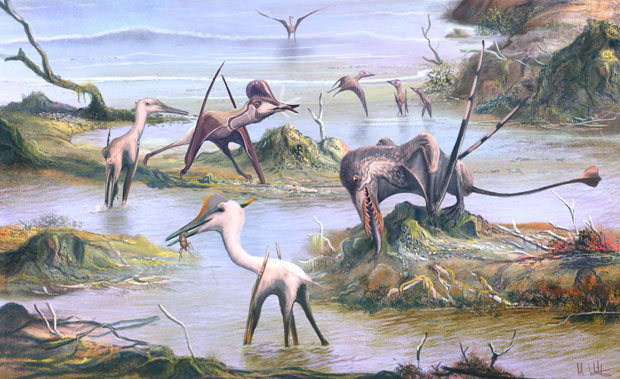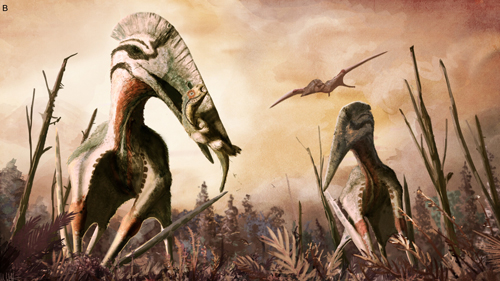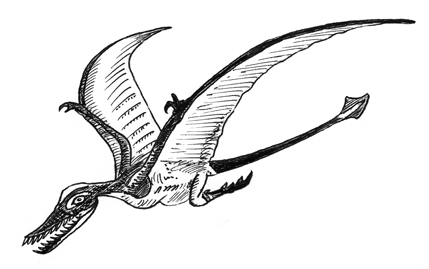Members of the Pterosauria Undergo Dental Examination
Visiting the dentist can be a daunting experience for some, but for seventeen different species of pterosaur, a microscopic analysis of wear on the teeth has provided palaeontologists with a fresh perspective on the diets and lifestyles of these enigmatic flying reptiles.
Scientists from the University of Birmingham and the University of Leicester’s Centre for Palaeobiology Research studied dental wear patterns preserved on the fossilised teeth of the specimens and then compared these wear patterns to those found on the teeth of living reptiles including crocodilians and monitor lizards whose diets are known.
A Newly Published Scientific Paper Reveals New Data on the Diets of Pterosaurs

Picture credit: Mark Witton
Studying Pterosaur Teeth
The researchers were able to demonstrate for the first time how microscopic dental wear analysis can be used to inform palaeontologists about the diet of an extinct animal but to also challenge existing ideas and perceptions about lifestyle and behaviour.
The scientific paper detailing their results are published in the academic journal “Nature Communications”.
Lead author of the study, Dr Jordan Bestwick (University of Birmingham’s School of Geography, Earth and Environmental Sciences), commented:
“Most existing ideas about what pterosaurs ate come from comparisons of the shapes of their teeth with those of living animals. For example, if the animal had conical teeth like a crocodile, we might assume it ate fish. But this approach has obvious shortcomings – the teeth of pandas and polar bears, for example, are similar, but comparing them wouldn’t give us an accurate picture of their diets.”
Did Some Super-sized Pterosaurs Eat Dinosaurs?

Picture credit: Mark Witton
Durophagus Diets
The analysis showed that modern reptiles with rougher wear on their tooth surfaces are more likely to have eaten crunchy things, such as shelled invertebrates – beetles or crabs. Eating hard-shelled animals or creatures with a tough exoskeleton such as some types of insect is referred to as durophagy. Reptiles which eat mainly soft items, such as fish, have smoother tooth surfaces, which show less wear. By applying the technique to pterosaurs, the scientists were able to comment on the likely diet of each species.
Dr Bestwick added:
“Our analysis has yielded some fascinating insights into individual species, but also into some of the bigger questions around how these pterosaurs evolved and whether their lifestyles were more similar to those of extant birds or reptiles. Evidence from dental microwear analysis can shed new light on this debate.”
Professor Mark Purnell, Professor of Palaeobiology at the University of Leicester explained:
“This is the first time this technique has been applied in this way to ancient reptiles, and it’s great to find it works so well. Often, palaeontologists have very little to go on when trying to understand what extinct animals ate. This approach gives us a new tool, allowing us to move from what are sometimes little more than educated guesses, into the realms of solid science.”
Examining the Diet of Rhamphorhynchus
In one example, the team examined the teeth of Rhamphorhynchus, a long-tailed pterosaur from the Jurassic period. Researchers found that juvenile Rhamphorhynchus had insect-based diets, whereas their adult counterparts – about the size of a large seagull – were more likely to have eaten fish. This suggests a species in which the adults took little care of their young (precocial behaviour) – a behaviour that is common in reptiles and is not exhibited by birds.
A Rhamphorhynchus Illustration (R. muensteri)

Picture credit: Everything Dinosaur
Looking at Pterosaur Evolution
The research team also investigated whether their analysis could shed light on how different species of pterosaurs evolved. The first pterosaurs evolved during the Triassic and they survived until the very end of the Mesozoic some 66 million years ago, becoming extinct at the same time as their archosaur relatives the dinosaurs. In that time, according to the dental microwear analysis, there was a general shift in diet from invertebrates such as insects, towards a more meat or fish-based diet.
Commenting on the potential significance of this dietary shift, Dr Bestwick stated:
“We found that the earliest forms of pterosaurs ate mainly crunchy invertebrates. The shift towards eating fish or meat coincides with the evolution of birds. We think it’s possible, therefore, that competition with birds could explain the decline of smaller-bodied pterosaurs and a rise in larger, carnivorous species.”
Birds Competing with Pterosaurs
It is an intriguing thought, although the fossil record of the Pterosauria is far from complete and there is a degree of bias towards the most productive pterosaur-fossil bearing strata such as deposits associated with the Crato and Santana Formations of the Early Cretaceous, which prevents a detailed assessment of pterosaur diversity over the duration of the Mesozoic from the Norian onwards.
Natalia Jagielska, a PhD researcher in pterosaur palaeontology based at the University of Edinburgh, (not involved in this study), commented that the research adds much-needed clarity to the behaviour and ecological role of pterosaurs in ancient food webs.
“Pterosaurs are a fascinating group of Mesozoic reptiles with astounding diversity in tooth morphology. This study is important for contributing to the idea that young Rhamphorhynchus were independent invertebrate hunters before becoming fish consumers, rather than being fed and nurtured by parents, like birds. Or that in pterosaur-rich environments, like the Late Jurassic Bavarian lagoons, pterosaur species have partitioned to occupy variations of dietary niches.”
The authors of the scientific paper are confident that this new research will provide a benchmark assisting in the interpretation of the diet of long extinct reptiles and in doing so, will lead to an improved understanding of ancient ecosystems.
Everything Dinosaur acknowledges the contribution of a media release from the University of Birmingham in the compilation of this article.
The Everything Dinosaur website: Everything Dinosaur.






Leave A Comment